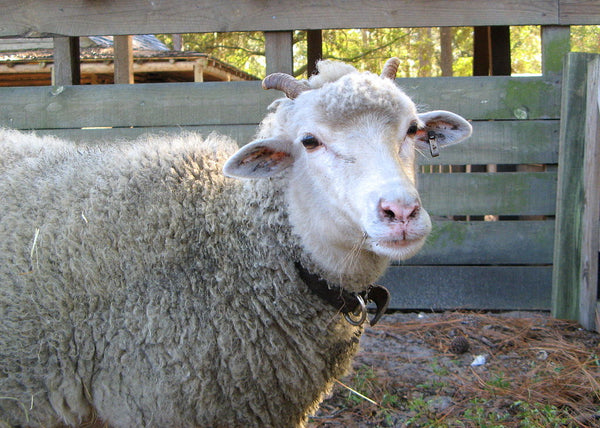Know Your Fiber: Gulf Coast Native Wool
Posted on February 01 2022

Woods sheep, Pineywoods sheep, Scrub sheep, Louisiana Native, Florida Native – all names for what we today call the Gulf Coast or Gulf Coast Native sheep. This landrace breed is particularly well adapted to the heat and humidity of the South and the Gulf Coast, but with less than two hundred registered sheep in the US, they are an endangered breed that is unfortunately not as well known or used as other sheep breeds.
Although their origins are somewhat shrouded in mystery, most livestock historians seem to agree that Gulf Coast Native sheep are descended from Churra sheep, a native Spanish breed, brought to Florida in the 1500s by the Spanish for their wool, milk, and meat. It is likely that they arrived with Spanish conquistador Pedro Menéndez de Avilés, who brought his fleet and soldiers to attack the French settlement of Fort Caroline. Once Menéndez defeated the French, he set up his own settlement on the same site, populating it with both soldiers and missionaries.
The Catholic missionaries that Menéndez had brought over did not have success in converting the local tribes. Indeed, the local tribes would frequently the missions, killing many of the missionaries. It is unclear if the native tribes of the area raised captured sheep for themselves, as the Navajo did with the sheep they captured. However, it does not seem too unlikely given that there are historical records of the local tribes raising the captured cattle.
Regardless of what happened to the original Churras brough over by Menéndez in the 1500s, Churras would spread throughout the rest of the Gulf Coast region over the next century. Spanish settlers and missionaries continued to arrive in North America to pick up where the original missionaries and settlers left off, and they brough their sheep with them. By the time the US made the Louisiana Purchase, followed by the purchase of Spanish Florida, the descendants of the original Churra sheep were already well on their way to becoming a unique North American breed. Improving sheep by crossing them with other breeds was very much the thing to do by the late 1700s. As a result, Churras were crossed independently by many sheep farmers with various Spanish, French, and English breeds such as Merinos, Rambouillets, Southdowns, Dorest Horns, and Cheviots. Some livestock historians think there may even be some Tunis in the mix.
If you are not familiar with the term “landrace sheep breed,” it is simply a term used for a breed that develops when a population of sheep are largely left on their own to adapt to the terrain, weather, and native forage. When this is done (intentionally or otherwise) the pressures of natural selection create a sheep that is particularly well suited to its environment. This process is exactly what happened to the Gulf Coast Native since it was a widespread practice for hundreds of years for sheep farmers of the region to simply release their sheep into the pine woods and scrub of the Gulf Coast for much of the year. Different herds of sheep would mingle with each other, creating new lambs and eating whatever native grasses and shrubs they could find. It was an inexpensive and easy way to keep sheep, and it was not uncommon for someone to stumble upon a herd of sheep out in the wild, living their best life, while travelling through the region. Once or twice a year, sheep farmers would round up the sheep to put their earmark on new lambs, gather wool, and send on some of the herd to the meat market. In this way, the Gulf Coast Native grew to be wonderfully adapted the hot and humid weather of the Gulf Coast.
Gulf Coast Natives were the sheep of choice for centuries around the hot and humid parts Gulf Coast region, well after the United States became a nation. Few sheep were as well adapted to heat and humidity as the Gulf Coast Natives, and they provided wool for the many people who were unable to afford finer and more expensive imported wool. Although not as silky-soft as the finest Merino, Gulf Coast Natives still produced a wool that was quite comfortable to wear next to the skin. Gulf Coast Native sheep would remain the preferred sheep for Gulf Coast farmers all the way through to the early 1900s. Why, you ask? It was largely because English breeds simply did not have enough resistance to the parasites of the area, making the mortality and production rate of those breeds undesirable to any farmer who was trying to make a living.
This would all begin to change as better anti-parasite medications began to be developed during the first part of the 1900s. Better anti-parasite medications meant that it was suddenly possible to raise healthy sheep that were larger and produced greater quantities of wool around the Gulf Coast and the South. Because of this, the less productive and smaller Gulf Coast Native sheep began to lose their allure. With the advent of WWII and the push to produce ever greater quantities of wool, interest in keeping Gulf Coast Native sheep severely declined as better producing commercial breeds took hold.
Soon, only a few families in the region would preserve this rare breed. Gulf Coast Native sheep declined rapidly in the decades following WWII, and soon only several herds remained. There has recently been a resurgence of interest in the breed, though, and more farmers have becoming interested in working to preserve it. The Gulf Coast Native sheep’s significant resistance to parasites, its ability to thrive on brush and sparse grasses in hot and humid climates, and its ability to breed out of season has meant that modern livestock researchers are making strides in preserving the breed for its genetics. Such traits are incredibly important for farmers who want to raise sheep in warm and humid climates. To this end, research flocks are currently kept by the University of Florida, Louisiana State University, and by the USDA Agricultural Research Service. Additionally, small farmers are reviving interest in this breed for its wool, milk, and meat.
Gulf Coast Native sheep are usually white, but there are some of the sheep are brown or black, or that have spotted faces and legs. As a part of their adaptation to hot and humid climates, they have no wool on their faces, legs, or cute little bellies. Both the males and females can have horns or be polled, but most small farmers prefer to raise the polled sheep. The wool of the Gulf Coast Native sheep ranges from about 26-32 microns and it is comfortable for most people to wear directly against their skin. Crimp can range a bit from wavy to curly depending on the individual sheep, and the staple is typically between 2 ½-4 inches long. Felters love this wool, too! However, crafters working with Gulf Coast Native wool should note that it is not uncommon for the wool to have at least a little bit of hair in it. We like to think of this as a feature since it gives the wool a bit more protection from wear and creates a bit of visual interest as well.
Interested in trying out some of this rare North American wool? We are fortunate to work with a mill out of Florida that specializes in rare regional wools. We purchase the wool directly from the mill and run it through our carder at our shop to produce batts for you to work with. As with all rare wools, our supply depends upon the season and availability. That means that when we have it in stock, that is the time to order. Have fun and cover the world in yarn, Northwest Yarns Nation!
Image by Jenny from Tallahassee, USA, CC BY 2.0 via Wikimedia Commons

Follow US